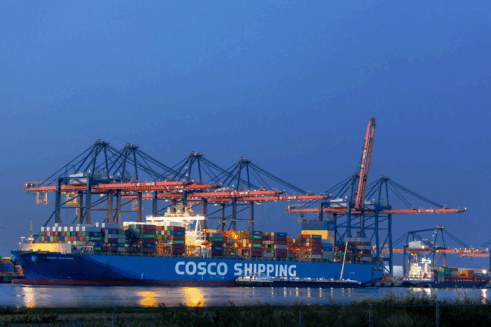The shipping industry is witnessing a remarkable surge in ocean container rates, particularly on the eastbound trans-Pacific route. According to a report by Xeneta, mid-high average spot rates for shipments from the Far East to the U.S. East Coast have skyrocketed by 88% since May 3, now standing at $6,100 per forty-foot equivalent unit (FEU). This dramatic increase highlights the eagerness of shippers to absorb higher costs to facilitate the movement of goods, spurred by the temporary U.S.-China reciprocal tariff pause.
Read also: Container Shipping Sees $9.9B Q1 Profit as Red Sea Disruptions Ease, But Momentum Slows
On the Far East to U.S. West Coast route, average spot rates have climbed to $5,082 from $2,615 per FEU, reflecting a similar trend of rising costs. The North Europe to U.S. East Coast route has not been immune to these changes, with average spot rates increasing to $2,129 from $2,081 within a week.
Liner operators such as Cosco, Evergreen, Hapag-Lloyd, and HMM have responded by increasing their spot rate charges, with some hikes reaching as high as $3,000 per FEU. By early June, mid-high spot rates from the Far East to the U.S. East Coast had surged by 67%, reaching $7,180 per FEU, as businesses rushed to expedite shipments amidst volatile trade conditions. Meanwhile, the Far East to U.S. West Coast rate stood at $6,100 per TEU.
These price dynamics extend beyond the trans-Pacific trade. The Far East to North Europe route has experienced a 32% rise in mid-high shipping rates since late May, now priced at $2,704 per FEU, despite a substantial four-week rolling average capacity of 346,000 TEUs as of June 5. This capacity level surpasses even the peak periods of the COVID-19 pandemic shipping rush.
Xeneta Chief Analyst Peter Sand commented, “The 88% increase in market mid-high spot rates on the trans-Pacific trade shows shippers are so concerned about getting goods moving again during the 90-day window of opportunity of lower tariffs that they are willing to pay more.” Sand anticipates this spike in rates to be temporary, with capacity returning to the trans-Pacific route and supply chains gradually recovering, leading to a decrease in pricing pressures.
These fluctuations have ripple effects on other trade routes like the Far East to North Europe. Although indirectly impacted by the U.S.-China tariff situation, this route feels the repercussions of global supply chain uncertainties. Sand noted, “What happens in one region can quickly ripple across global supply chains,” highlighting the interconnected nature of global trade and the potential for increased capacity pressure alongside geopolitical unpredictability to influence spot rates even in distant markets.

